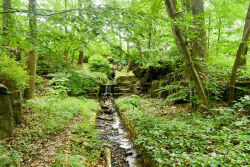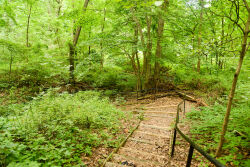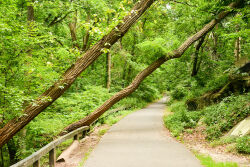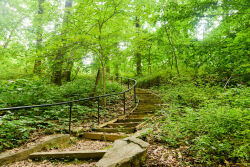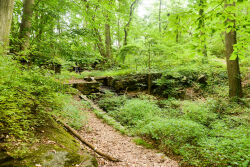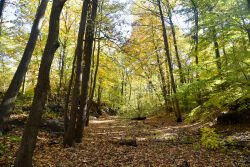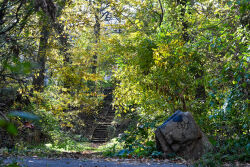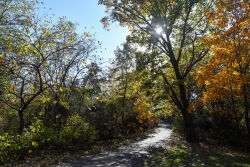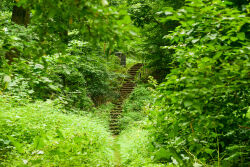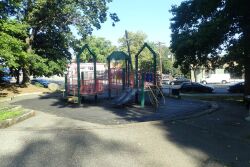Seton Falls Park
The Daily Plant : Friday, March 9, 2001
NATURAL RESOURCES GROUP FOREST RESTORATION IN ACTION
Parks has over 5,200 acres of forest in its over 28,000-acre system. While many park users think that trees can take care of themselves, in many cases, nothing could be further from the truth. Parks' forests face a variety of threats, among them, erosion, non-native invasive plants, encroachment, and acid rain.
In many forests, the most serious problem is posed by invasive non-native vegetation, plant species that were introduced into North America for landscaping purposes and have spread into the environment. Vine species such as oriental bittersweet (Celastrus orbiculatus) and porcelainberry (Ampelopsis brevipedunculata) can kill large trees by strangulation. They also shade or suffocate tree seedlings, the future generation of trees. These vines can overrun large areas, killing the mature trees, and preventing the germination of new seedlings. Invasive shrubs such as Tatarian honeysuckle (Lonicera tatarica) and Multiflora rose (Rosa multiflora) crowd out native shrubs and groundcovers, degrading the habitat for songbirds and other wildlife. Unfortunately, once an area becomes overrun, it stays that way, requiring human intervention to set things right.
Natural Resources Group's (NRG) Forest Restoration Team treats over 10 acres every year, removing large infestations of vines, and replanting the sites with native trees and shrubs. They also sweep over 20 acres of forest every year to remove large vines before they can invade healthy forest. The team's current projects include Alley Pond Park in Queens, Inwood Hill Park in Manhattan, and Seton Falls Park in the Bronx. These projects are supported by state, federal, and private grants that exceed $1.7 million.
Like a playground in need of reconstruction, the forest is ready for new plantings when the unwanted plants have been removed. In 2000, the team planted 11,241 trees and shrubs of 43 species. They were planted with a combination of volunteer and paid labor in the spring and fall. (We even plant in the rain!) The Oaks, Maples and Tulip Poplars that were planted represent the future of the forest, and although they are but a few feet tall now, in 15-20 years they will be 40 feet tall, filtering air, providing cover and food for wildlife, and keeping New York City's Parks green.
By Tim (Timberwolf) Wenskus, NRG Forester
SURANGI PUNYASENA LEAVES PARKS
Today is Surangi (Kitul) Punyasena's last day with Parks. Surangi started with the Natural Resources Group in September 1999 as a Special Projects Coordinator. Since then, she's helped coordinate the federal and state agencies that participate in the Harbor Estuary Program (HEP), and edited and overseen the publication of a report on the New York/New Jersey Harbor. Surangi looks forward to her next position, in the Paleobiology Department of the Smithonian's Natural History Museum.
THIRTEEN YEARS AGO IN THE PLANT
(Friday, March 18, 1988)
GIANT PARKS VACUUM DONATED BY RICHMOND HILL RESIDENTS
A "Giant-Vac," donated by the Richmond Hill Block Association, was presented to Queens Parks Commissioner William H. Cook at a ceremony last Saturday at the Richmond Hill Savings Bank located at 115-12 Jamaica Avenue. The vacuum will be used to clean leaves and other debris at Forest Park in Queens.
Funds for the vacuum were raised at an annual fall fair at Forest Park sponsored by the Richmond Hill Block Association and the Richmond Hill Savings Bank.
QUOTATION FOR THE DAY
"The beautiful changes as a forest is changed
by a chameleon's tuning his skin to it."
Richard Purdy Wilbur (b. 1921)
Check out your park's Vital Signs
Clean & Safe
Green & Resilient
Empowered & Engaged Users
Share your feedback or learn more about how this park is part of a
Vital Park System

